Analyzing and Visualizing Text Information in Corporate Sustainability Reports Using Natural Language Processing Methods
Abstract
:1. Introduction
2. Literature Review
3. Material and Methods
3.1. Data Collection
3.2. Text Pre-Processing
3.3. Thematic Analysis
3.3.1. Method Selection
3.3.2. Text Vectorization
3.3.3. Sentence Similarity Measurement
3.4. Sentiment Analysis
4. Results and Discussion
4.1. Similarity Score Distribution Comparison
4.2. Thematic Analysis
4.3. Sentiment Analysis
5. Conclusions
Author Contributions
Funding
Institutional Review Board Statement
Informed Consent Statement
Data Availability Statement
Conflicts of Interest
Appendix A
| No | Year | Sustainability Leaders Report |
|---|---|---|
| 1 | 2011 | The Sustainability Survey 2011 |
| 2 | 2012 | The 2012 Sustainability Leaders |
| 3 | 2013 | The 2013 Sustainability Leaders |
| 4 | 2014 | The 2014 Sustainability Leaders |
| 5 | 2015 | The 2015 Sustainability Leaders |
| 6 | 2016 | The 2016 Sustainability Leaders |
| 7 | 2017 | The 2017 Sustainability Leaders: Celebrating 20 Years of Leadership |
| 8 | 2018 | The 2018 Sustainability Leaders |
| 9 | 2019 | The 2019 Sustainability Leaders |
| 10 | 2020 | The 2020 Sustainability Leaders |
Appendix B
| No | Company Name | Sustainability Report |
|---|---|---|
| 1 | BASF | BASF Report 2011 Economic, environmental and social performance |
| 2 | BASF Report 2012 Economic, environmental and social performance | |
| 3 | BASF Report 2013 Economic, environmental and social performance | |
| 4 | BASF Report 2014 Economic, environmental and social performance | |
| 5 | BASF Report 2015 Economic, environmental and social performance | |
| 6 | BASF Report 2016 Economic, environmental and social performance | |
| 7 | BASF Report 2017 Economic, environmental and social performance | |
| 8 | BASF Report 2018 Economic, environmental and social performance | |
| 9 | BASF Report 2019 Economic, environmental and social performance | |
| 10 | BASF Report 2020 Economic, environmental and social performance | |
| 11 | IKEA | Sustainability Report 2011 |
| 12 | Sustainability Report 2012 | |
| 13 | Sustainability Report 2013 | |
| 14 | Sustainability Report 2014 | |
| 15 | Sustainability Report 2015 | |
| 16 | Sustainability Report 2016 | |
| 17 | Sustainability Report 2017 | |
| 18 | Sustainability Report 2018 | |
| 19 | Sustainability Report 2019 | |
| 20 | Sustainability Report 2020 | |
| 21 | Marks & Spencer | How We Do Business Report 2011 |
| 22 | How We Do Business Report 2012 | |
| 23 | Plan A Report 2013 | |
| 24 | Plan A Report 2014 | |
| 25 | Plan A Report 2015 | |
| 26 | Plan A Report 2016 | |
| 27 | Plan A Report 2017 | |
| 28 | Plan A Report 2018 | |
| 29 | Plan A: Performance update 2019 | |
| 30 | Plan A Report 2020 | |
| 31 | Nestle | Creating Shared Value Summary Report 2011 |
| 32 | Creating Shared Value and meeting our commitments 2012 | |
| 33 | Creating Shared Value and meeting our commitments 2013 | |
| 34 | Creating Shared Value and meeting our commitments 2014 | |
| 35 | Creating Shared Value and meeting our commitments 2015 | |
| 36 | Creating Shared Value and meeting our commitments 2016 | |
| 37 | Creating Shared Value and meeting our commitments 2017 | |
| 38 | Creating Shared Value and meeting our commitments 2018 | |
| 39 | Creating Shared Value and meeting our commitments 2019 | |
| 40 | Creating Shared Value and Sustainability Report 2020 | |
| 41 | Toyota | Sustainability Report 2011 |
| 42 | Sustainability Report 2012 | |
| 43 | Sustainability Report 2013 | |
| 44 | Sustainability Report 2014 | |
| 45 | Sustainability Report 2015 | |
| 46 | Sustainability Data Book 2016 | |
| 47 | Sustainability Data Book 2017 | |
| 48 | Sustainability Data Book 2018 | |
| 49 | Sustainability Data Book 2019 | |
| 50 | Sustainability Data Book 2020 | |
| 51 | Walmart | Global Responsibility Report 2011 |
| 52 | Global Responsibility Report 2012 | |
| 53 | Global Responsibility Report 2013 | |
| 54 | Global Responsibility Report 2014 | |
| 55 | Global Responsibility Report 2015 | |
| 56 | Global Responsibility Report 2016 | |
| 57 | Global Responsibility Report 2017 | |
| 58 | Global Responsibility Report 2018 | |
| 59 | Environmental, Social & Governance Report 2019 | |
| 60 | Environmental, Social & Governance Report 2020 |
References
- Keeble, B.R. The Brundtland report: ‘Our common future’. Med. War 1988, 4, 17–25. [Google Scholar] [CrossRef]
- Kuhlman, T.; Farrington, J. What is Sustainability? Sustainability 2010, 2, 3436–3448. [Google Scholar] [CrossRef] [Green Version]
- Junior, R.M.; Best, P.J.; Cotter, J. Sustainability Reporting and Assurance: A Historical Analysis on a World-Wide Phenomenon. J. Bus. Ethics 2014, 120, 1–11. [Google Scholar] [CrossRef] [Green Version]
- Calabrese, A.; Costa, R.; Ghiron, N.L.; Menichini, T. To be, or not to be, that is the question. Is sustainability report reliable? Eur. J. Sustain. Dev. 2017, 6, 519–526. [Google Scholar] [CrossRef]
- Hinds, P.J. The curse of expertise: The effects of expertise and debiasing methods on prediction of novice performance. J. Exp. Psychol. Appl. 1999, 5, 205–221. [Google Scholar] [CrossRef]
- Carlile, P.R.; Rebentisch, E.S. Into the Black Box: The Knowledge Transformation Cycle. Manag. Sci. 2003, 49, 1180–1195. [Google Scholar] [CrossRef]
- SDG Compass. SDG Compass: A Guide for Business Action to Advance the Sustainable Development Goals. SDG Compass. 2015. Available online: https://sdgcompass.org (accessed on 15 February 2022).
- Modapothala, J.R.; Issac, B. Evaluation of Corporate Environmental Reports Using Data Mining Approach. In Proceedings of the 2009 International Conference on Computer Engineering and Technology, Singapore, 22–24 January 2009; Volume 2, pp. 543–547. [Google Scholar]
- Modapothala, J.R.; Issac, B.; Jayamani, E. Appraising the Corporate Sustainability Reports—Text Mining and Multi-Discriminatory Analysis. In Innovations in Computing Sciences and Software Engineering; Springer: Dordrecht, The Netherlands, 2010; pp. 489–494. [Google Scholar] [CrossRef]
- Shahi, A.M.; Issac, B.; Modapothala, J.R. Intelligent Corporate Sustainability Report Scoring Solution Using Machine Learning Approach to Text Categorization. In Proceedings of the 2012 IEEE Conference on Sustainable Utilization and Development in Engineering and Technology (STUDENT), Kuala Lumpur, Malaysia, 6–9 October 2012; pp. 227–232. [Google Scholar] [CrossRef]
- Liew, W.T.; Adhitya, A.; Srinivasan, R. Sustainability trends in the process industries: A text mining-based analysis. Comput. Ind. 2014, 65, 393–400. [Google Scholar] [CrossRef]
- Landrum, N.E.; Ohsowski, B. Identifying Worldviews on Corporate Sustainability: A Content Analysis of Corporate Sustainability Reports. Bus. Strat. Environ. 2018, 27, 128–151. [Google Scholar] [CrossRef] [Green Version]
- Amini, M.; Bienstock, C.C.; Narcum, J.A. Status of corporate sustainability: A content analysis of Fortune 500 companies. Bus. Strat. Environ. 2018, 27, 1450–1461. [Google Scholar] [CrossRef]
- Wang, X.; Yuen, K.F.; Wong, Y.D.; Li, K.X. How can the maritime industry meet Sustainable Development Goals? An analysis of sustainability reports from the social entrepreneurship perspective. Transp. Res. Part D Transp. Environ. 2020, 78, 102173. [Google Scholar] [CrossRef]
- Brookes, G.; McEnery, A. The utility of topic modelling for discourse studies: A critical evaluation. Discourse Stud. 2019, 21, 3–21. [Google Scholar] [CrossRef] [Green Version]
- Benites-Lazaro, L.; Giatti, L.; Giarolla, A. Topic modeling method for analyzing social actor discourses on climate change, energy and food security. Energy Res. Soc. Sci. 2018, 45, 318–330. [Google Scholar] [CrossRef]
- Székely, N.; vom Brocke, J. What can we learn from corporate sustainability reporting? Deriving propositions for research and practice from over 9500 corporate sustainability reports published between 1999 and 2015 using topic modelling technique. PLoS ONE 2017, 12, e0174807. [Google Scholar] [CrossRef] [Green Version]
- Kim, D.; Kim, S. Sustainable Supply Chain Based on News Articles and Sustainability Reports: Text Mining with Leximancer and DICTION. Sustainability 2017, 9, 1008. [Google Scholar] [CrossRef] [Green Version]
- Myšková, R.; Hájek, P. Sustainability and Corporate Social Responsibility in the Text of Annual Reports—The Case of the IT Services Industry. Sustainability 2018, 10, 4119. [Google Scholar] [CrossRef] [Green Version]
- Jindřichovská, I.; Kubíčková, D.; Mocanu, M. Case Study Analysis of Sustainability Reporting of an Agri-Food Giant. Sustainability 2020, 12, 4491. [Google Scholar] [CrossRef]
- Reyes-Menendez, A.; Saura, J.R.; Alvarez-Alonso, C. Understanding #WorldEnvironmentDay User Opinions in Twitter: A Topic-Based Sentiment Analysis Approach. Int. J. Environ. Res. Public Health 2018, 15, 2537. [Google Scholar] [CrossRef] [Green Version]
- Lee, R.; Kim, J. Developing a Social Index for Measuring the Public Opinion Regarding the Attainment of Sustainable Development Goals. Soc. Indic. Res. 2021, 156, 201–221. [Google Scholar] [CrossRef]
- Mahoney, L.S.; Thorne, L.; Cecil, L.; LaGore, W. A research note on standalone corporate social responsibility reports: Signaling or greenwashing? Crit. Perspect. Account. 2013, 24, 350–359. [Google Scholar] [CrossRef]
- Uyar, A.; Karaman, A.S.; Kilic, M. Is corporate social responsibility reporting a tool of signaling or greenwashing? Evidence from the worldwide logistics sector. J. Clean. Prod. 2020, 253, 119997. [Google Scholar] [CrossRef]
- Karaman, A.S.; Orazalin, N.; Uyar, A.; Shahbaz, M. CSR achievement, reporting, and assurance in the energy sector: Does economic development matter? Energy Policy 2021, 149, 112007. [Google Scholar] [CrossRef]
- Ruiz-Blanco, S.; Romero, S.; Fernandez-Feijoo, B. Green, blue or black, but washing–What company characteristics determine greenwashing? Environ. Dev. Sustain. 2021, 24, 4024–4045. [Google Scholar] [CrossRef]
- Lashitew, A.A. Corporate uptake of the Sustainable Development Goals: Mere greenwashing or an advent of institutional change? J. Int. Bus. Policy 2021, 4, 184–200. [Google Scholar] [CrossRef]
- Hetze, K. Effects on the (CSR) Reputation: CSR Reporting Discussed in the Light of Signalling and Stakeholder Perception Theories. Corp. Reput. Rev. 2016, 19, 281–296. [Google Scholar] [CrossRef]
- Ihlen, Ø.; Bartlett, J.; May, S. (Eds.) The Handbook of Communication and Corporate Social Responsibility; John Wiley & Sons: Hoboken, NJ, USA, 2011. [Google Scholar]
- KPMG. The time has come: The KPMG survey of sustainability reporting 2020. KPMG’s Global Center of Excellence for Climate Change and Sustainability. 2020. Available online: https://assets.kpmg/content/dam/kpmg/xx/pdf/2020/11/the-time-has-come.pdf (accessed on 15 February 2022).
- GlobeScan, The SustainAbility Institute. GlobeScan/SustainAbility Survey: 2021 Sustainability Leaders. GlobeScan Incorporated and ERM Worldwide Group. 2021. Available online: https://3ng5l43rkkzc34ep72kj9as1-wpengine.netdna-ssl.com/wp-content/uploads/2021/07/GlobeScan-SustainAbility-Leaders-Survey-2021-Report.pdf (accessed on 15 February 2022).
- McKie, J.X. PyMuPDF. 2016. Available online: https://github.com/pymupdf/PyMuPDF (accessed on 15 February 2022).
- Wu, J.; Guo, S.; Huang, H.; Liu, W.; Xiang, Y. Information and Communications Technologies for Sustainable Development Goals: State-of-the-Art, Needs and Perspectives. IEEE Commun. Surv. Tutor. 2018, 20, 2389–2406. [Google Scholar] [CrossRef] [Green Version]
- Camacho-Collados, J.; Pilehvar, M.T. On the Role of Text Preprocessing in Neural Network Architectures: An Evaluation Study on Text Categorization and Sentiment Analysis. arXiv 2017, arXiv:1707.01780. [Google Scholar]
- Loper, E.; Bird, S. Nltk: The natural language toolkit. arXiv 2002, arXiv:cs/0205028. [Google Scholar]
- Clarke, V.; Braun, V.; Hayfield, N. Thematic analysis. Qual. Psychol. A Pract. Guide Res. Methods 2015, 222, 248. [Google Scholar]
- Turian, J.; Ratinov, L.; Bengio, Y. Word Representations: A Simple and General Method for Semi-Supervised Learning. In Proceedings of the 48th Annual Meeting of the Association for Computational Linguistics, Uppsala, Sweden, 11–16 July 2010; pp. 384–394. Available online: https://aclanthology.org/P10-1040 (accessed on 18 February 2022).
- Wang, W.; Wei, F.; Dong, L.; Bao, H.; Yang, N.; Zhou, M. Minilm: Deep self-attention distillation for task-agnostic compression of pre-trained transformers. Adv. Neural Inf. Processing Syst. 2020, 33, 5776–5788. [Google Scholar] [CrossRef]
- Devlin, J.; Chang, M.W.; Lee, K.; Toutanova, K. Bert: Pre-training of deep bidirectional transformers for language understanding. arXiv 2018, arXiv:1810.04805. [Google Scholar]
- SBERT.net Models. Available online: https://www.sbert.net/_static/html/models_en_sentence_embeddings.html (accessed on 15 February 2022).
- Reimers, N.; Gurevych, I. Sentence-bert: Sentence embeddings using siamese bert-networks. arXiv 2019, arXiv:1908.10084. [Google Scholar]
- Tata, S.; Patel, J.M. Estimating the selectivity of tf-idf based cosine similarity predicates. ACM SIGMOD Rec. 2007, 36, 7–12. [Google Scholar] [CrossRef] [Green Version]
- Kramer, O. Scikit-Learn. In Machine Learning for Evolution Strategies; Springer: Cham, Switzerland, 2016; pp. 45–53. [Google Scholar] [CrossRef]
- Medhat, W.; Hassan, A.; Korashy, H. Sentiment analysis algorithms and applications: A survey. Ain Shams Eng. J. 2014, 5, 1093–1113. [Google Scholar] [CrossRef] [Green Version]
- Hoang, M.; Bihorac, O.A.; Rouces, J. Aspect-Based Sentiment Analysis Using BERT. In Proceedings of the 22nd Nordic Conference on Computational Linguistics, Turku, Finland, 30 September–2 October 2019; pp. 187–196. Available online: https://aclanthology.org/W19-6120 (accessed on 18 February 2022).
- Sanh, V.; Debut, L.; Chaumond, J.; Wolf, T. DistilBERT, a distilled version of BERT: Smaller, faster, cheaper and lighter. arXiv 2019, arXiv:1910.01108. [Google Scholar] [CrossRef]
- Hunter, J.D. Matplotlib: A 2D graphics environment. Comput. Sci. Eng. 2007, 9, 90–95. [Google Scholar] [CrossRef]
- Kang, H.; Yin, W.; Kim, J.; Moon, H.C. The Competitive Advantage of the Indian and Korean Film Industries: An Empirical Analysis Using Natural Language Processing Methods. Appl. Sci. 2022, 12, 4592. [Google Scholar] [CrossRef]
- Khattak, A.; Paracha, W.T.; Asghar, M.Z.; Jillani, N.; Younis, U.; Saddozai, F.K.; Hameed, I.A. Fine-Grained Sentiment Analysis for Measuring Customer Satisfaction Using an Extended Set of Fuzzy Linguistic Hedges; Atlantis Press: Amsterdam, The Netherlands, 2020. [Google Scholar] [CrossRef]
- Tao, J.; Fang, X. Toward multi-label sentiment analysis: A transfer learning based approach. J. Big Data 2020, 7, 1. [Google Scholar] [CrossRef] [Green Version]
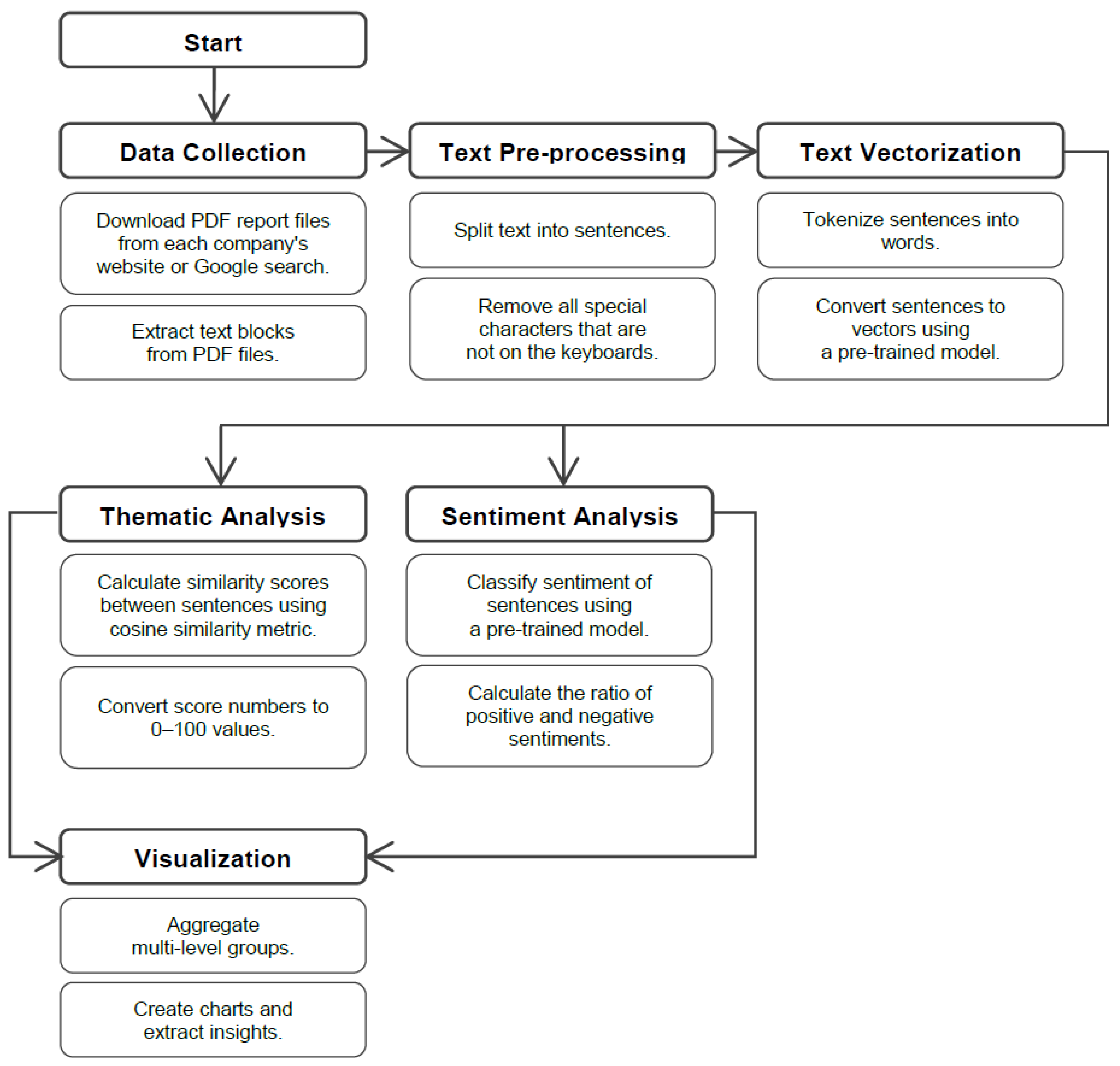
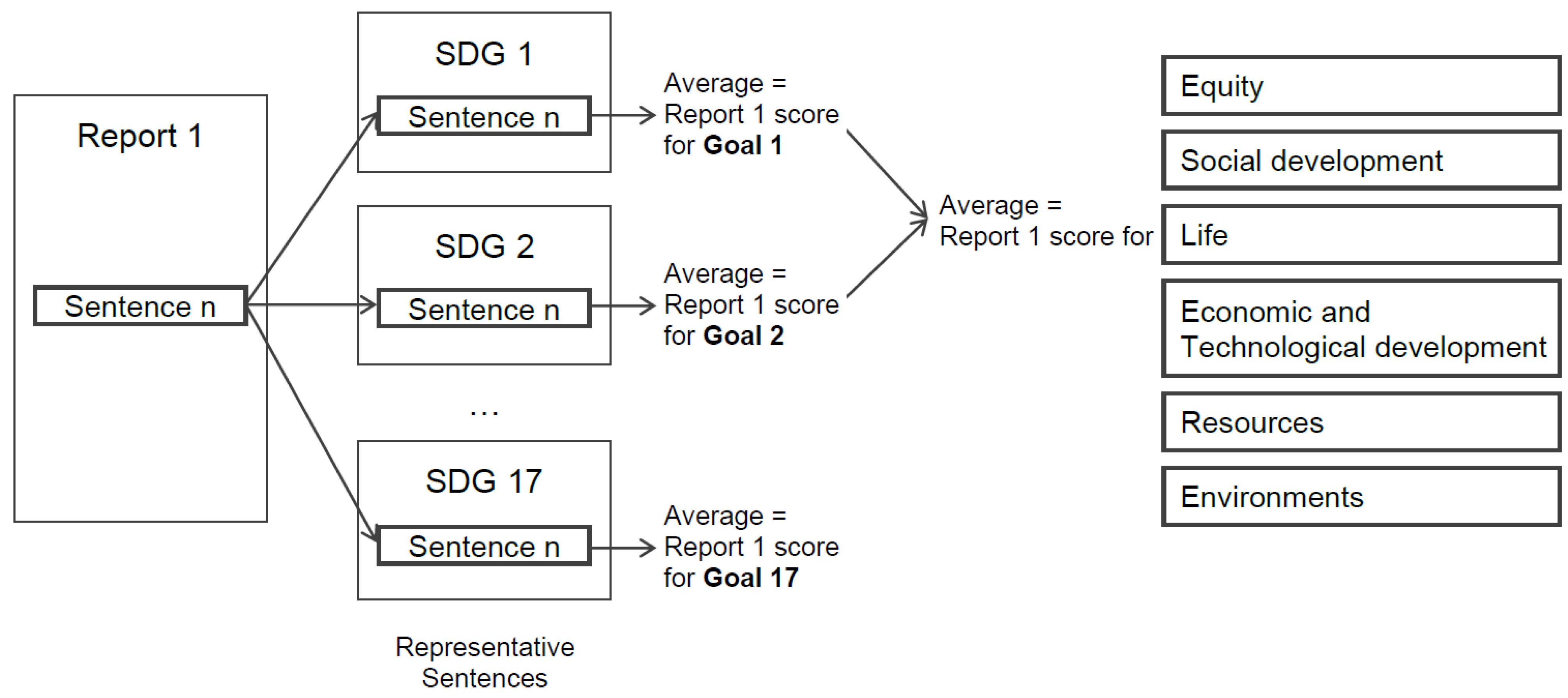

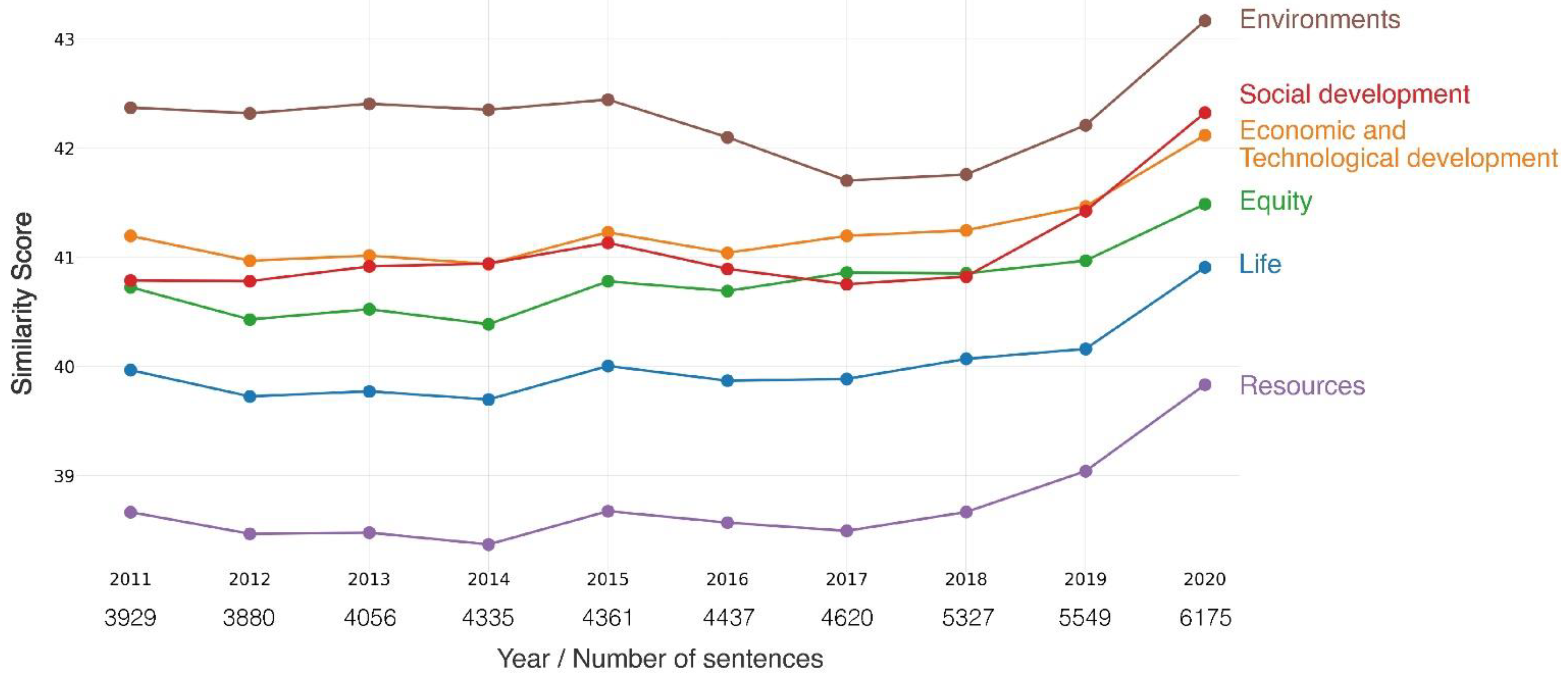
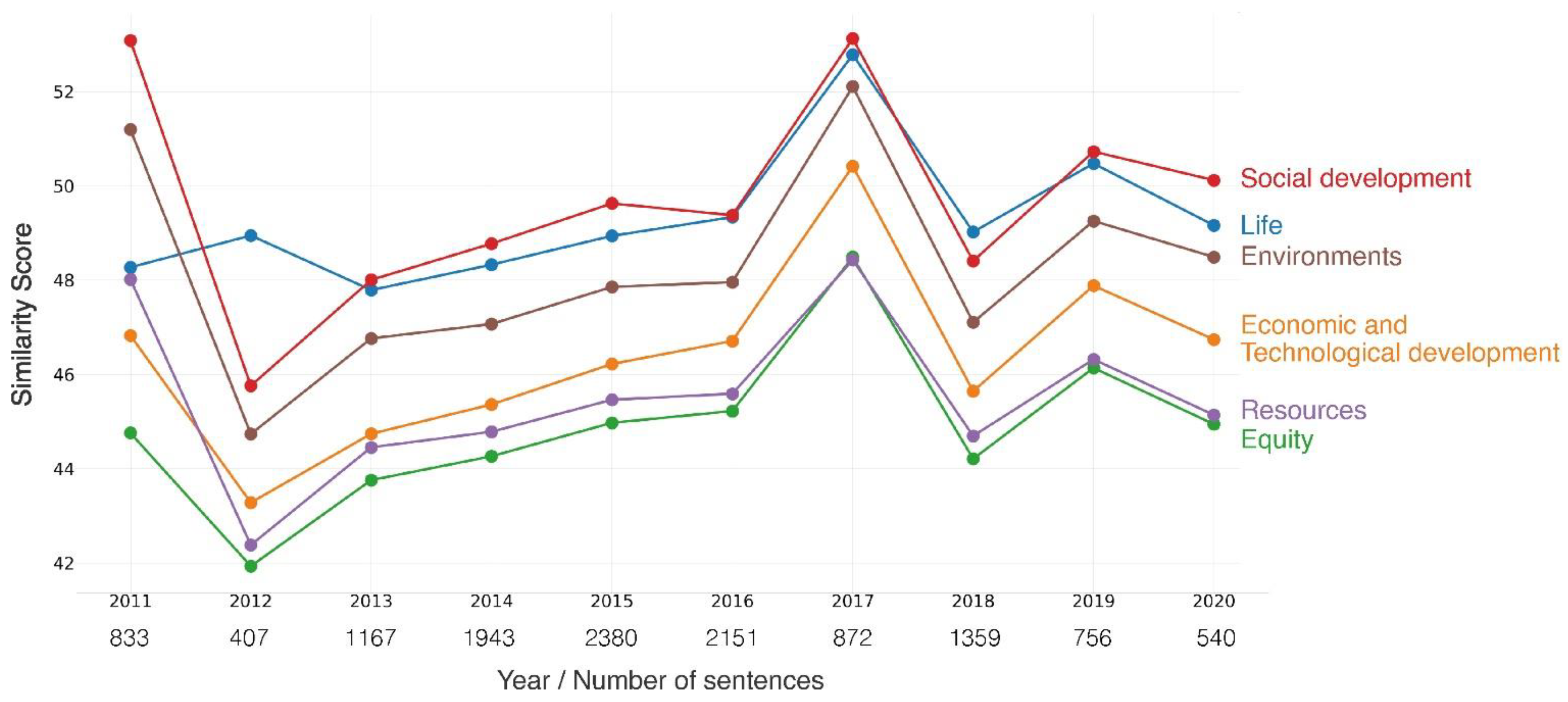
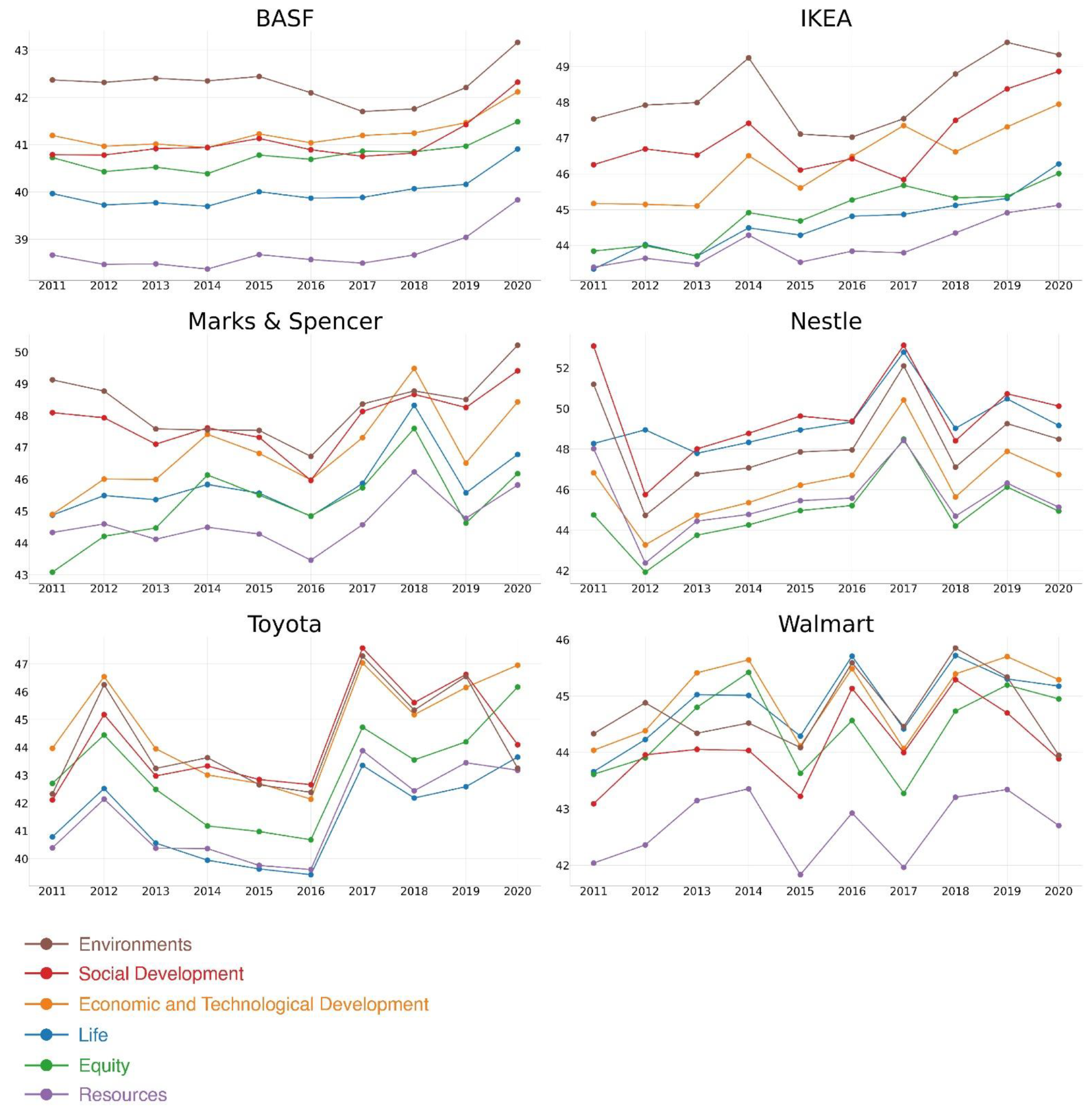
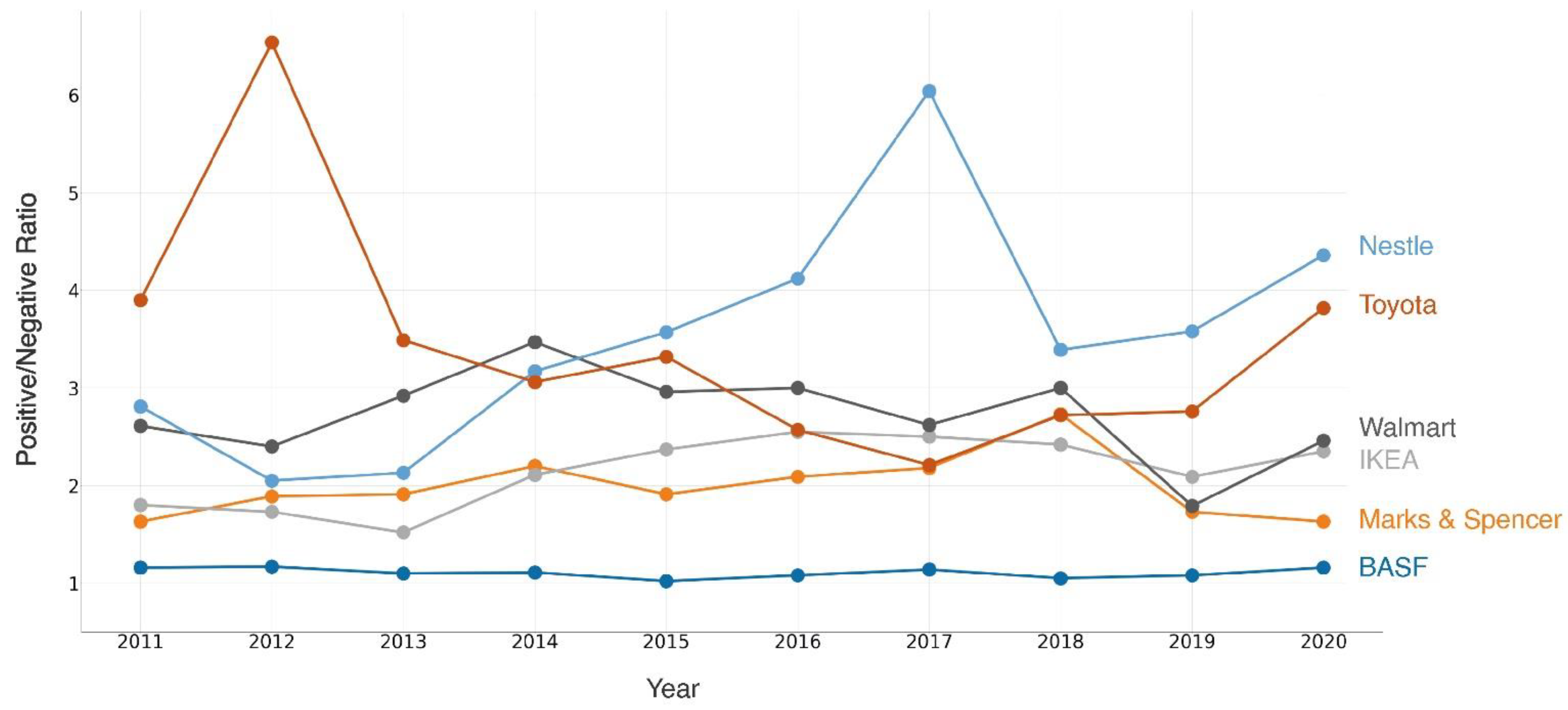
| Company Name | Country | 2011 | 2012 | 2013 | 2014 | 2015 | 2016 | 2017 | 2018 | 2019 | 2020 |
|---|---|---|---|---|---|---|---|---|---|---|---|
| Apple | US | 9 | |||||||||
| (1) BASF | Germany | 9 | 7 | 10 | |||||||
| Coca Cola | US | 9 | |||||||||
| Co-operative | (unknown) | 10 | |||||||||
| Danone | France | 8 | 6 | 6 | |||||||
| General Electric | US | 2 | 3 | 5 | 8 | 8 | 9 | 7 | |||
| US | 10 | ||||||||||
| (2) IKEA | Sweden | 6 | 4 | 4 | 4 | 3 | 3 | ||||
| Interface | US | 3 | 2 | 3 | 3 | 3 | 3 | 3 | 3 | 4 | 4 |
| (3) Marks & Spencer | UK | 5 | 6 | 6 | 4 | 4 | 8 | 5 | 5 | 8 | |
| Microsoft | US | 9 | |||||||||
| Natura | Brazil | 6 | 7 | 10 | 6 | 5 | 7 | 5 | 5 | 5 | |
| (4) Nestle | Switzerland | 5 | 7 | 6 | 6 | 7 | 7 | 8 | |||
| NIKE | US | 8 | 8 | 7 | 10 | 7 | |||||
| Novo Nordisk | Denmark | 9 | 9 | ||||||||
| Orsted | Denmark | 10 | |||||||||
| Patagonia | US | 7 | 4 | 2 | 2 | 2 | 2 | 2 | 2 | 2 | 2 |
| Puma | Germany | 7 | 10 | ||||||||
| Siemens | Germany | 10 | |||||||||
| Tesla | US | 5 | 5 | 6 | 9 | 7 | |||||
| (5) Toyota | Japan | 8 | |||||||||
| Unilever | UK | 1 | 1 | 1 | 1 | 1 | 1 | 1 | 1 | 1 | 1 |
| (6) Walmart | US | 4 | 5 | 4 | 9 | 10 |
| Social | |||
|---|---|---|---|
| Equity | Social Development | ||
| Goal 4 Goal 5 Goal 10 | Quality education Gender equality Reduced inequalities | Goal 11 Goal 16 Goal 17 | Sustainable cities and communities Peace justice and strong institutions Partnerships for the goals |
| Economic | |||
| Life | Economic and Technological development | ||
| Goal 1 Goal 2 Goal 3 | No poverty Zero hunger Good health and well-being | Goal 8 Goal 9 | Decent work and economic growth Industry, innovation, and infrastructure |
| Environmental | |||
| Resources | Environments | ||
| Goal 6 Goal 7 Goal 12 Goal 14 | Clean water and sanitation Affordable and clean energy Responsible consumption and production Life below water | Goal 13 Goal 15 | Climate action Life on land |
| No | Doc ID | File Name | Sentence |
|---|---|---|---|
| 0 | 0 | BASF_2011.pdf | The cover photo shows a Berlin subway during the … |
| 1 | 0 | BASF_2011.pdf | The branding motifs shown in this report, taken from … |
| 2 | 0 | BASF_2011.pdf | You can find this and other publications from BAS… |
| 3 | 0 | BASF_2011.pdf | The cover photo shows a Berlin subway during the… |
| 4 | 0 | BASF_2011.pdf | The branding motifs shown in this report, taken from … |
| … | … | … | … |
| 109168 | 59 | Walmart_2020.pdf | Additional methodology information can be found in our … |
| 109169 | 59 | Walmart_2020.pdf | 36 This metric has been adjusted to account for the… |
| 109170 | 59 | Walmart_2020.pdf | In other words, Brazil s energy use and square footage … |
| 109171 | 59 | Walmart_2020.pdf | The adjusted baseline result is 11.25% vs. 2010. |
| 109172 | 59 | Walmart_2020.pdf | The unadjusted result (with Brazil still included in … |
| No | Category | Goal | Sentence |
|---|---|---|---|
| 0 | Life | Goal 1 | End poverty in all its forms everywhere |
| 1 | Life | Goal 1 | Despite progress under the MDGs, approximately … |
| 2 | Life | Goal 1 | Over the past decade, markets in developing countries … |
| 3 | Life | Goal 1 | Certain groups are disproportionately represented … |
| 4 | Life | Goal 1 | These include women, persons with disabilities, … |
| … | … | … | … |
| 636 | Social development | Goal 17 | 17.16 Enhance the global partnership for sustainable … |
| 637 | Social development | Goal 17 | 17.17 Encourage and promote effective public, … |
| 638 | Social development | Goal 17 | Data, monitoring and accountability |
| 639 | Social development | Goal 17 | 17.18 By 2020, enhance capacity-building support to … |
| 640 | Social development | Goal 17 | 17.19 By 2030, build on existing initiatives to develop … |
| Company | Country | Sentence | Label | Score |
|---|---|---|---|---|
| BASF | Germany | We develop innovative solutions for and with our customers to expand our leading position. | Positive | 1.00 |
| In the long term, we want to increase the share of this oil to cover our total demand. | Positive | 0.60 | ||
| In recent years, hot and dry summers often led to extended low water levels on the Rhine River, temporarily impacting logistics. | Negative | 0.30 | ||
| BASF was especially affected by the downturn in the automotive sector. | Negative | 0.00 | ||
| IKEA | Sweden | The climate footprint of the IKEA value chain continued to decrease during FY20, and we saw big improvements across the business. | Positive | 1.00 |
| Risk assessments have been completed for the entire IKEA value chain, to determine the main focus areas where we can have the biggest impact based on our business. | Positive | 0.70 | ||
| For example, some minerals have specific qualities that are difficult to substitute with alternatives, particularly in electronics. | Negative | 0.32 | ||
| The world is experiencing a dramatic loss of species and ecosystems. | Negative | 0.00 | ||
| Marks & Spencer | UK | Over the past year, we have begun this transition, embedding sustainability into our business operations. | Positive | 1.00 |
| REPUTATION Growing stakeholder expectations of responsible corporate behaviour. | Positive | 0.60 | ||
| We will provide a more accurate figure for total food surplus next year. | Negative | 0.13 | ||
| Around a quarter of these international stores total footage uses energy provided by the landlord and is outside our operational control. | Negative | 0.00 | ||
| Nestle | Switzerland | We have made significant progress on our journey to sustainable packaging too. | Positive | 1.00 |
| From this, we developed a new risk assessment tool to understand child labor risks across all the priority commodities we buy. | Positive | 0.80 | ||
| Of these, 464 cases were substantiated and related to issues such as abuse of power and/or harassment/bullying, labor practices and kickbacks. | Negative | 0.31 | ||
| This situation has only become more challenging as a result of the COVID-19 pandemic. | Negative | 0.00 | ||
| Toyota | Japan | Toyota strives to be a good corporate citizen trusted by all stakeholders and to contribute to Creating an Affluent Society through all its business operations. | Positive | 1.00 |
| To this end, Toyota constantly seeks to enhance corporate governance. | Positive | 0.87 | ||
| We also recognize that human rights abuses such as child labor in the procurement of cobalt etc. | Negative | 0.26 | ||
| The invention of such batteries proved to be extremely difficult, and none have yet been completed. | Negative | 0.00 | ||
| Walmart | US | We provide convenient access to high-quality, affordable food and other essential products and services to millions of people each week. | Positive | 1.00 |
| Walmart associates receive ethics training during onboarding and regularly thereafter. | Positive | 0.74 | ||
| In any given year, an increase or decrease in UPC volume weight disclosures may impact reporting. | Negative | 0.39 | ||
| No one organization can single-handedly transform supply chain systems. | Negative | 0.00 |
| Mean | Standard Deviation | Minimum | Maximum | |
|---|---|---|---|---|
| Keyword matching | 20.72 | 0.03 | 20.67 | 21.02 |
| Sentence similarity | 43.15 | 10.42 | 4.09 | 89.86 |
Publisher’s Note: MDPI stays neutral with regard to jurisdictional claims in published maps and institutional affiliations. |
© 2022 by the authors. Licensee MDPI, Basel, Switzerland. This article is an open access article distributed under the terms and conditions of the Creative Commons Attribution (CC BY) license (https://creativecommons.org/licenses/by/4.0/).
Share and Cite
Kang, H.; Kim, J. Analyzing and Visualizing Text Information in Corporate Sustainability Reports Using Natural Language Processing Methods. Appl. Sci. 2022, 12, 5614. https://doi.org/10.3390/app12115614
Kang H, Kim J. Analyzing and Visualizing Text Information in Corporate Sustainability Reports Using Natural Language Processing Methods. Applied Sciences. 2022; 12(11):5614. https://doi.org/10.3390/app12115614
Chicago/Turabian StyleKang, Hyewon, and Jinho Kim. 2022. "Analyzing and Visualizing Text Information in Corporate Sustainability Reports Using Natural Language Processing Methods" Applied Sciences 12, no. 11: 5614. https://doi.org/10.3390/app12115614
APA StyleKang, H., & Kim, J. (2022). Analyzing and Visualizing Text Information in Corporate Sustainability Reports Using Natural Language Processing Methods. Applied Sciences, 12(11), 5614. https://doi.org/10.3390/app12115614







